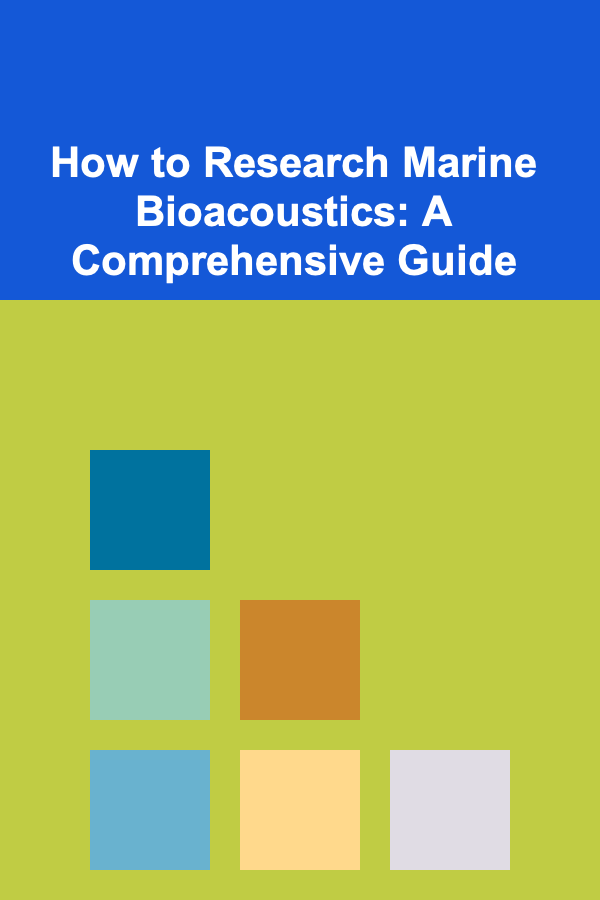
How to Research Marine Bioacoustics: A Comprehensive Guide
ebook include PDF & Audio bundle (Micro Guide)
$12.99$8.99
Limited Time Offer! Order within the next:

Marine bioacoustics is a fascinating and increasingly important field, bridging the gap between biology and acoustics to study the production, reception, and effects of sound in marine organisms. From the songs of whales to the snapping of shrimp, the underwater world is a symphony (and sometimes a cacophony) of sounds. Understanding these sounds is crucial for conservation efforts, mitigating anthropogenic noise pollution, and unlocking the secrets of marine animal behavior. This guide provides a comprehensive overview of how to conduct research in marine bioacoustics, covering everything from foundational knowledge to advanced techniques.
I. Laying the Groundwork: Knowledge and Skills
Before diving into research, it's essential to build a strong foundation of knowledge and skills. This involves academic preparation, technical proficiency, and a deep understanding of the marine environment.
A. Academic Foundations
A strong academic background is paramount. Consider the following areas of study:
- Biology/Marine Biology: A solid understanding of marine animal physiology, behavior, ecology, and evolution is critical. Focus on courses covering marine mammals, fish, invertebrates, and their interactions within the ecosystem.
- Acoustics/Physics: Knowledge of sound propagation, signal processing, and transducer technology is essential. Courses in acoustics, physics, and electrical engineering will provide a valuable foundation. Pay particular attention to underwater acoustics, which differs significantly from acoustics in air due to factors like salinity, temperature, and pressure.
- Mathematics/Statistics: Bioacoustics research often involves complex data analysis. Strong mathematical and statistical skills are necessary for analyzing acoustic signals, modeling animal behavior, and interpreting results. Courses in calculus, linear algebra, statistics (especially time series analysis), and signal processing are highly recommended.
- Programming: Proficiency in programming languages like Python, R, or MATLAB is invaluable for data analysis, signal processing, and developing custom tools. Python, with its extensive libraries for scientific computing (NumPy, SciPy, Matplotlib, Pandas), is particularly popular in the field.
B. Technical Skills
Beyond academic knowledge, developing practical technical skills is crucial for conducting fieldwork and analyzing data:
- Underwater Acoustics Equipment Handling: Learn how to use hydrophones (underwater microphones), sound level meters, acoustic recorders, and other specialized equipment. Understanding the limitations and calibration procedures of each instrument is vital for accurate data collection. Practice deployment and retrieval techniques, both from small boats and research vessels.
- Signal Processing Techniques: Master signal processing techniques for analyzing acoustic data. This includes spectral analysis (e.g., Fourier transforms, spectrograms), filtering, noise reduction, and sound classification. Learn to identify and characterize different types of marine sounds, including animal vocalizations, ambient noise, and anthropogenic noise.
- Data Analysis and Visualization: Develop skills in data analysis using software packages like MATLAB, R, or Python. Learn to perform statistical analysis, create visualizations (e.g., spectrograms, time series plots), and interpret the results.
- Underwater Navigation and Survey Techniques: Depending on the research focus, skills in underwater navigation, GPS operation, and acoustic survey techniques (e.g., towed arrays, sonobuoys) may be required.
- Boat Handling and Safety: If fieldwork involves working from boats, obtain certifications in boat handling, navigation, and safety. Learn about weather forecasting, emergency procedures, and basic marine engineering.
- Animal Handling (if applicable): If the research involves handling marine animals, obtain the necessary permits and training. Learn about ethical considerations, animal welfare, and safe handling techniques.
C. Understanding the Marine Environment
A thorough understanding of the marine environment is essential for interpreting acoustic data and designing effective research studies:
- Oceanography: Learn about ocean currents, temperature gradients, salinity variations, and other oceanographic features that can affect sound propagation and animal distribution.
- Marine Ecology: Understand the ecological relationships between marine organisms, including predator-prey interactions, habitat preferences, and the impact of environmental changes.
- Marine Conservation: Be aware of the conservation challenges facing marine ecosystems, including pollution, overfishing, climate change, and habitat destruction. Understand the legal and regulatory frameworks governing marine conservation.
- Species Identification: Develop the ability to identify different species of marine animals based on their vocalizations and other acoustic cues. This requires familiarity with species-specific call characteristics, geographic variations, and the acoustic repertoire of different populations.
II. Identifying a Research Question and Defining Objectives
The first step in any research project is to identify a compelling research question. This question should be specific, measurable, achievable, relevant, and time-bound (SMART). Once you have a research question, you can define clear and measurable objectives that will help you answer it.
A. Finding a Research Question
Consider the following strategies for identifying potential research questions:
- Literature Review: Conduct a thorough review of the existing literature in marine bioacoustics. Identify gaps in knowledge, unresolved questions, and areas where further research is needed. Use keywords like "marine bioacoustics," "underwater sound," "marine mammal vocalizations," "anthropogenic noise," "acoustic ecology," and specific species names to search academic databases (e.g., Web of Science, Scopus, Google Scholar).
- Attend Conferences and Workshops: Attend conferences and workshops related to marine bioacoustics. This is a great way to learn about the latest research findings, network with experts in the field, and identify emerging research topics.
- Talk to Experts: Reach out to researchers and experts in marine bioacoustics. Discuss your interests and ask for their advice on potential research questions. Many researchers are happy to mentor students and provide guidance.
- Observe the Natural World: Spend time observing marine animals in their natural habitat. Pay attention to their behavior, vocalizations, and interactions with the environment. This can spark new ideas for research questions.
- Consider Current Conservation Issues: Focus on research questions that address pressing conservation issues, such as the impact of noise pollution on marine animals, the effectiveness of marine protected areas, or the effects of climate change on acoustic communication.
Examples of research questions in marine bioacoustics:
- How does anthropogenic noise affect the foraging behavior of humpback whales?
- What is the acoustic repertoire of bottlenose dolphins in a specific geographic region?
- Can passive acoustic monitoring be used to detect the presence of endangered marine species?
- How does ocean acidification affect the sound production and hearing abilities of marine invertebrates?
- What is the role of acoustic communication in the social behavior of clownfish?
B. Defining Objectives
Once you have a research question, you need to define specific and measurable objectives. Objectives are the steps you will take to answer your research question.
Examples of objectives:
- To record and analyze the vocalizations of humpback whales in a specific feeding ground.
- To measure the levels of anthropogenic noise in a marine protected area.
- To assess the hearing sensitivity of a specific species of fish using auditory evoked potential (AEP) testing.
- To model the propagation of sound in a shallow-water environment.
- To develop a machine learning algorithm for classifying marine animal vocalizations.
III. Research Methods and Techniques
Marine bioacoustics research employs a variety of methods and techniques, depending on the research question and objectives. These methods can be broadly categorized into passive acoustics, active acoustics, controlled experiments, and modeling.
A. Passive Acoustics
Passive acoustics involves listening to and recording sounds in the marine environment without actively emitting sound signals. This is a powerful tool for studying marine animal behavior, monitoring population distributions, and assessing the impact of noise pollution.
- Hydrophone Deployment: Hydrophones can be deployed in various configurations, including:
- Autonomous Acoustic Recorders (AARs): These self-contained units can be deployed for extended periods to record sounds in remote locations. They are typically battery-powered and store data on internal memory cards.
- Towed Arrays: These are arrays of hydrophones towed behind a research vessel. They allow for the detection and localization of sound sources over a large area.
- Fixed Observatories: These are permanent underwater observatories equipped with hydrophones and other sensors. They provide continuous acoustic monitoring of specific locations.
- Drifting Buoys/Sonobuoys: Disposable, often air-deployed, buoys that transmit acoustic data back to a receiver. Useful for large-scale surveys.
- Data Analysis: Acoustic data collected with hydrophones is analyzed using signal processing techniques to identify and characterize sounds of interest. This includes:
- Spectrogram Analysis: Spectrograms are visual representations of sound frequency over time. They are used to identify and classify different types of marine sounds.
- Automatic Sound Detection and Classification: Machine learning algorithms can be used to automatically detect and classify marine animal vocalizations. This can significantly reduce the amount of time required for data analysis. Tools like Raven Pro and Pamguard are commonly used.
- Source Localization: Techniques like time-difference-of-arrival (TDOA) can be used to estimate the location of sound sources based on the arrival times of sound at multiple hydrophones.
- Applications:
- Species Distribution and Abundance: Passive acoustics can be used to monitor the presence and abundance of marine animals by detecting their vocalizations.
- Behavioral Studies: By analyzing the vocalizations of marine animals, researchers can gain insights into their social behavior, foraging strategies, and communication patterns.
- Noise Monitoring: Passive acoustics can be used to measure the levels of anthropogenic noise in the marine environment and assess its impact on marine animals.
B. Active Acoustics
Active acoustics involves transmitting sound signals into the water and analyzing the reflected or scattered signals. This technique is commonly used for mapping the seafloor, detecting fish schools, and studying the behavior of marine animals.
- Sonar Systems:
- Echo Sounders: These devices transmit sound pulses and measure the time it takes for the echoes to return. This information is used to create maps of the seafloor.
- Multibeam Sonar: These systems transmit multiple beams of sound simultaneously, providing a more detailed image of the seafloor than traditional echo sounders.
- Acoustic Cameras: Use high-frequency sound to create video-like images in low-visibility conditions.
- Acoustic Tags:
- Transmitters: Acoustic transmitters are attached to marine animals to track their movements. The transmitters emit coded signals that can be detected by hydrophones.
- Transponders: Acoustic transponders respond to a specific acoustic signal by emitting a reply signal. This allows for precise localization of the tagged animal.
- Applications:
- Seafloor Mapping: Active acoustics is used to create detailed maps of the seafloor, which are essential for navigation, resource management, and scientific research.
- Fish Stock Assessment: Active acoustics can be used to estimate the abundance and distribution of fish populations.
- Animal Tracking: Acoustic tags are used to track the movements of marine animals and study their behavior.
C. Controlled Experiments
Controlled experiments involve manipulating environmental variables and observing the responses of marine animals. This allows researchers to establish cause-and-effect relationships between specific stimuli and animal behavior.
- Playback Experiments: Playback experiments involve broadcasting recorded sounds to marine animals and observing their behavioral responses. This technique can be used to study the effects of noise pollution, communication signals, and predator calls. Careful consideration of experimental design is necessary to avoid habituation or sensitization of the animals.
- Auditory Evoked Potential (AEP) Testing: AEP testing involves measuring the electrical activity in the brain in response to auditory stimuli. This technique is used to assess the hearing sensitivity of marine animals. Requires specialized equipment and expertise.
- Behavioral Observation: Controlled experiments often involve careful observation of animal behavior before, during, and after exposure to a specific stimulus. This may include measuring swimming speed, vocalization rates, foraging behavior, and social interactions.
D. Modeling
Modeling involves using mathematical equations and computer simulations to predict the behavior of marine animals and the propagation of sound in the ocean. This can be used to test hypotheses, make predictions, and inform management decisions.
- Sound Propagation Models: These models simulate the propagation of sound in the ocean, taking into account factors such as water depth, temperature, salinity, and bottom type. Examples include BELLHOP, RAM, and others.
- Agent-Based Models: These models simulate the behavior of individual marine animals and their interactions with each other and the environment. They can be used to study the effects of environmental changes on population dynamics.
- Statistical Models: Statistical models are used to analyze data collected from field studies and controlled experiments. They can be used to identify patterns, test hypotheses, and make predictions.
IV. Data Collection and Analysis: Best Practices
Collecting and analyzing data in marine bioacoustics requires careful planning and execution. Adhering to best practices ensures the accuracy, reliability, and reproducibility of your research.
A. Planning and Preparation
- Obtain Permits and Approvals: Before conducting any fieldwork, obtain the necessary permits and approvals from relevant regulatory agencies. This may include permits for research activities, animal handling, and use of vessels.
- Calibrate Equipment: Regularly calibrate all acoustic equipment to ensure accurate measurements. This includes hydrophones, sound level meters, and acoustic recorders.
- Develop a Detailed Protocol: Develop a detailed protocol for data collection and analysis. This should include clear instructions for deploying equipment, recording data, and processing signals. A well-defined protocol ensures consistency and reduces the risk of errors.
- Pilot Study: Conduct a pilot study to test your methods and identify any potential problems. This allows you to refine your protocol and optimize your data collection efforts.
- Data Management Plan: Develop a comprehensive data management plan that outlines how you will organize, store, and back up your data. This is crucial for ensuring the long-term preservation and accessibility of your research data. Use descriptive file names, create metadata, and follow established data management standards.
B. Data Collection
- Minimize Noise Interference: Take steps to minimize noise interference during data collection. This may involve choosing quiet locations, using noise-canceling headphones, and shielding equipment from electromagnetic interference.
- Record Metadata: Record detailed metadata about each data point, including the date, time, location, equipment used, and environmental conditions. This information is essential for interpreting the data and ensuring its reproducibility.
- Maintain a Detailed Logbook: Keep a detailed logbook of all activities, observations, and events that occur during data collection. This can be invaluable for troubleshooting problems and interpreting results.
- Ensure Data Integrity: Implement procedures to ensure the integrity of your data. This may involve using checksums to verify the accuracy of data transfers, and regularly backing up your data to multiple locations.
C. Data Analysis
- Use Appropriate Signal Processing Techniques: Choose signal processing techniques that are appropriate for your research question and data. This may involve using filters, spectral analysis, and other techniques to extract meaningful information from the acoustic data.
- Validate Results: Validate your results using multiple methods. This may involve comparing your results to previous studies, using different signal processing techniques, or conducting statistical tests.
- Document Analysis Steps: Document all of your analysis steps in detail. This ensures that your analysis is transparent and reproducible. Use a version control system (e.g., Git) to track changes to your code and data analysis scripts.
- Consider Statistical Power: Ensure that your study has sufficient statistical power to detect meaningful effects. This may involve increasing the sample size, using more sensitive measurement techniques, or employing more powerful statistical tests. Perform power analyses a priori to determine appropriate sample sizes.
- Address Potential Biases: Be aware of potential biases in your data and analysis. This may involve using control groups, blinding the analyst, or using statistical techniques to correct for biases.
V. Ethical Considerations
Research in marine bioacoustics must be conducted ethically, with careful consideration for the welfare of marine animals and the environment.
- Minimize Disturbance: Take steps to minimize disturbance to marine animals during data collection. This may involve using non-invasive techniques, avoiding sensitive habitats, and limiting the duration of exposure to acoustic stimuli.
- Avoid Harm: Do not harm marine animals during research. This includes avoiding physical injury, stress, and disruption of natural behaviors.
- Obtain Informed Consent: If your research involves human subjects (e.g., divers, fishermen), obtain informed consent before collecting any data. Explain the purpose of the research, the potential risks and benefits, and the rights of the participants.
- Data Privacy: Protect the privacy of human subjects by anonymizing data and obtaining their consent before sharing it with others.
- Transparency and Openness: Be transparent about your research methods and results. Share your data and code with other researchers to promote collaboration and reproducibility. Publish your findings in peer-reviewed journals and present them at conferences.
- Adhere to Regulations: Comply with all applicable laws, regulations, and guidelines related to marine research, animal welfare, and environmental protection.
VI. Resources and Opportunities
Marine bioacoustics is a growing field with numerous resources and opportunities for researchers.
A. Academic Programs
Many universities offer graduate programs in marine bioacoustics or related fields. Look for programs with faculty members who are actively involved in research and have expertise in your area of interest.
B. Research Institutions
Several research institutions conduct cutting-edge research in marine bioacoustics. These institutions often offer internships, fellowships, and postdoctoral positions for aspiring researchers. Examples include:
- Woods Hole Oceanographic Institution (WHOI)
- Scripps Institution of Oceanography
- National Oceanic and Atmospheric Administration (NOAA) Fisheries
- University of Washington, Applied Physics Laboratory
C. Professional Organizations
Join professional organizations related to marine bioacoustics. These organizations provide opportunities for networking, collaboration, and professional development. Examples include:
- Acoustical Society of America (ASA)
- Society for Marine Mammalogy (SMM)
- European Cetacean Society (ECS)
D. Funding Opportunities
Explore funding opportunities from government agencies, foundations, and private organizations. Common funding sources include:
- National Science Foundation (NSF)
- National Oceanic and Atmospheric Administration (NOAA)
- Office of Naval Research (ONR)
- Sea Grant Programs
- Various private foundations focused on ocean conservation.
E. Software and Tools
Utilize specialized software and tools for data analysis and visualization. Some popular options include:
- Raven Pro: Software for sound analysis from the Cornell Lab of Ornithology.
- Pamguard: Open-source software for passive acoustic monitoring.
- MATLAB: Commercial software with powerful signal processing capabilities.
- R: Open-source statistical computing environment.
- Python with libraries like NumPy, SciPy, and Matplotlib.
VII. Future Directions in Marine Bioacoustics
The field of marine bioacoustics is constantly evolving, with new technologies and research questions emerging all the time. Some promising future directions include:
- Advancements in Sensor Technology: The development of smaller, cheaper, and more sensitive hydrophones and acoustic recorders will allow for more widespread and detailed monitoring of the marine environment.
- Artificial Intelligence and Machine Learning: AI and machine learning are being used to automate the detection and classification of marine animal vocalizations, analyze large datasets, and predict animal behavior.
- Acoustic Ecology: Acoustic ecology is an emerging field that studies the relationships between organisms and their acoustic environment. This approach emphasizes the importance of understanding the entire soundscape, including both natural and anthropogenic sounds.
- Climate Change Impacts: Researching the impact of ocean acidification and warming on marine animal sound production and reception will be crucial.
- Noise Mitigation Strategies: Developing and evaluating strategies for mitigating the impact of anthropogenic noise on marine animals is a critical area of research. This includes exploring quieter shipping technologies, developing noise barriers, and establishing marine protected areas.
VIII. Conclusion
Researching marine bioacoustics is a challenging but rewarding endeavor. By building a strong foundation of knowledge and skills, developing clear research questions, employing appropriate methods, and adhering to ethical principles, you can contribute to our understanding of the underwater world and help protect marine ecosystems. The future of marine bioacoustics is bright, and there are countless opportunities for passionate researchers to make a difference.
This guide provides a starting point for your journey into marine bioacoustics research. Remember to stay curious, collaborate with other researchers, and always prioritize the welfare of marine animals and the environment.
Disclaimer: This document is for informational purposes only and should not be considered professional advice. Always consult with experienced researchers and relevant regulatory agencies before conducting any research in marine bioacoustics.

How to Budget for Unexpected Costs During a Home Renovation
Read More
How to Create an Efficient Home Workout Storage Solution
Read More
How to Make a Grant Reporting Checklist for Volunteer-Driven Projects
Read More
How to Organize Emergency Supplies for Volunteer Activities
Read More
How to Update Your Home's Plumbing During Renovation
Read More
How To Create a Remarketing Strategy
Read MoreOther Products

How to Budget for Unexpected Costs During a Home Renovation
Read More
How to Create an Efficient Home Workout Storage Solution
Read More
How to Make a Grant Reporting Checklist for Volunteer-Driven Projects
Read More
How to Organize Emergency Supplies for Volunteer Activities
Read More
How to Update Your Home's Plumbing During Renovation
Read More